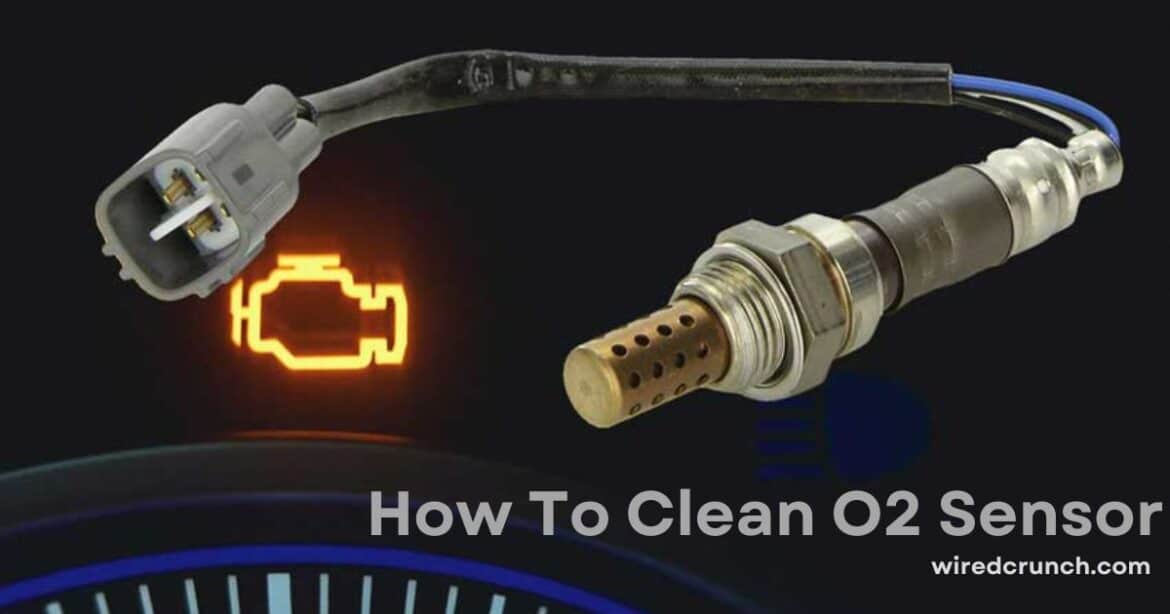The O2 sensor also called as an oxygen sensor or an emissions sensor, is super important in a car’s engine. It keeps an eye on how much oxygen is in the exhaust gases, which helps control the fuel mixture. If this sensor gets dirty, it can make the “check engine” light come on and even make the car less fuel-efficient. So, it’s a big deal! In this exploration, we’ll break down what exactly the oxygen sensor does and why it’s so crucial for how our cars run and how they impact the environment.

Table of Contents
Symptoms of a unclean O2 sensor:
- Decreased Fuel Efficiency: Dirty O2 sensor leads to inefficient fuel combustion, decreasing MPG.
- Poor Engine Performance: Causes rough idling, hesitation, or stalling due to inaccurate air-fuel mixture.
- Increased Emissions: Higher levels of harmful pollutants emitted, failing emissions tests.
- Check Engine Light (CEL) Illumination: Sensor irregularities trigger the CEL on the dashboard.
- Rough Idle: Disrupts idle speed control, resulting in inconsistent engine operation.
- Delayed Response: Engine response to throttle inputs is delayed, especially during acceleration.
- Failed Emissions Test: Increased emissions lead to test failure during inspections.

How to clean O2 sensor-steps
01.Preparing for the Cleaning Process
- Safety gloves and goggles
- O2 sensor cleaner
- Wire/tooth brush
- Clean water for rinsing
- Compressed air
- Anti-seize compound
Safety Precautions:
- Ensure the vehicle is parked on a level surface with the parking brake engaged.
- Allow the exhaust system to cool down before working on it to avoid burns.
- If you’re working underneath the vehicle, use jack stands and other safety precautions to prevent accidents.
02. Removing the O2 Sensor
- Locate the Sensor : The O2 sensor(s) are usually located on the exhaust system, either near the exhaust manifold or further downstream on the exhaust pipe.Consult your vehicle’s service manual or use an online resource to locate the specific sensor(s) in your vehicle.
- Disconnect Electrical Connection : Before removing the sensor, locate and disconnect the electrical connector that attaches to it. This connector may have a locking tab that needs to be pressed or a retaining clip that needs to be released.
- Unscrew the Sensor : Apply steady, even pressure in a counterclockwise direction to loosen the sensor.Be cautious not to twist the sensor wires or put excessive force on them, as they can be delicate.
03. Cleaning Methods for O2 Sensors
- Soaking in Solvent : You can soak the sensor in a mild solvent such as gasoline or alcohol to remove dirt and deposits. However, be cautious as some solvents can damage the sensor.
- Using a Wire Brush or Wire Wheel : There are sensor cleaners available on the market specifically designed for cleaning oxygen sensors. Follow the instructions on the product carefully.
- Heating : Heating the sensor can sometimes help burn off carbon deposits. You can try heating it with a propane torch or by running the engine until it’s hot.
- Ultrasonic Cleaning : In ultrasonic cleaning, high-frequency sound waves are used to create cavitation bubbles in a cleaning solution. These bubbles implode near the surface of the sensor, effectively scrubbing away dirt and contaminants.
04. Cleaning the O2 Sensor
- Spray or soak the sensor in the cleaner solution : Depending on the cleaner and the level of buildup on the sensor, you may choose to either spray the cleaner directly onto the sensor or soak it in the solution. Follow the instructions provided with the cleaner for the best results.If spraying, ensure thorough coverage of the sensor and allow the cleaner to penetrate any buildup. Use a brush or soft cloth to gently scrub away stubborn residue if needed.If soaking, submerge the sensor in the cleaner solution according to the recommended duration. Again, use a brush or cloth to gently remove any remaining buildup after soaking.
- scrub the sensor with a brush : When cleaning an O2 sensor, gently scrubbing it with a soft-bristled brush can help remove stubborn residue. Just be sure to use a cleaner specifically designed for O2 sensors and follow any manufacturer instructions carefully to avoid damaging the sensor.
- Rinse the sensor with clean water : After scrubbing the O2 sensor with a soft-bristled brush to remove buildup, rinse it thoroughly with clean water to remove any remaining cleaner residue. This step helps ensure that no cleaning solution is left on the sensor, which could potentially interfere with its performance.
- Use compressed air to dry the sensor : Using compressed air to dry a sensor, particularly one used for cleaning oxygen, is a common and efficient method in various industrial and scientific applications. When sensors are exposed to moisture or contaminants, it can compromise their accuracy and performance.

05. Reinstalling the O2 Sensor
- Apply anti-seize compound to the new sensor’s threads
- Tighten the sensor with a wrench
- Reconnect the electrical connector
06. Testing and Verifying the O2 Sensor
- Use an OBD scanner to check for error codes related to the O2 sensor
- With a digital multimeter, test the sensor’s signal wire voltage while the engine is running
- Clear any error codes
- Test drive to confirm smooth operation

How to Clean O2 Sensor without removing it
Cleaning an oxygen (O2) sensor without removing it involves using a specialized sensor-safe cleaner. Locate the sensor under the vehicle, then carefully spray the cleaner onto its tip and surrounding area. Allow it to soak as per the cleaner’s instructions. While this method may offer some improvement, it might not be as effective as removing the sensor for thorough cleaning. Drive the vehicle afterward to help burn off any remaining residue.
What is the fastest way to clean an O2 sensor?
- Remove the sensor if accessible.
- Spray O2 sensor safe cleaner directly on the sensing element.
- Allow it to soak for recommended time.
- Gently scrub away debris if needed.
- Rinse (if required) and dry thoroughly.
- Reinstall the sensor securely.
- Test engine performance for improvements.
Conclusion
In addition to using specialized sensor cleaning solutions, there are alternative methods for cleaning an oxygen (O2) sensor, although their effectiveness may vary. For instance, some DIY enthusiasts suggest soaking the sensor in various solutions such as vinegar or rubbing alcohol to dissolve contaminants.Ultimately, maintaining a clean and properly functioning O2 sensor is essential for the efficient operation of the vehicle’s engine and emission control system. By following recommended cleaning procedures or seeking professional assistance when necessary, drivers can ensure that their vehicles run smoothly, consume fuel efficiently, and produce minimal harmful emissions, contributing to both environmental sustainability and driving satisfaction.
READ MORE :
How to Fix Low Speed Braking Control Problem Parking Sensor Obstructed Issue
How to Fix Tire Sensor Fault in Ford Explorer
How to Troubleshoot Front Assist without Sensor View
Transmission Sensor Replacement Cost



